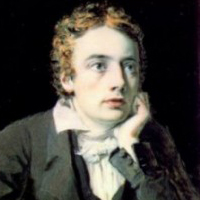The Terror of Death (When I have Fears) by John Keats: Summary and Analysis
This is the first sonnet of Keats, written in the Shakespearean form with its abab, cdcd, efef, gg rhyme scheme and its division into three quatrains and a concluding couplet. It was written between January, 22nd, and 31st, 1818. Though the poem is sent to Reynolds on 31 January, 1818, calling it 'thy last sonnet,' it is not the poet's last sonnet in any way.

John Keats (1795-1821)
It is essential to mention that Keats was obsessed with death and his family members are slowly disappearing. He himself felt like impending death hovering over him. Many critics agree this poem is rather a death centered reading than a poetry centered. It is not merely the poem of a poet, but a poem about life and death.
Though Keats fear death in this poem, most of his poems have dealt with the theme of death, death of nature, death of love, and death of memory. Keats experiences the feeling of impending death and he suddenly worries about the volumes of poetry, he has to compose before he dies. He may never be able to write long romances that are in his mind and he may not see the beautiful women and can never feel the passionate love. He starts feeling alone and concludes that the love and fame has nothing to do in the mortal life. And he comforts himself stating that death is not such a terrible situation to be worried about.
The first two quatrains are splendid. In the sonnet "When I have fears that I may cease to be", prophetically conscious of his premature death, he sighs for being compelled to leave his dear pursuits. Wealth of books and beauty and mystery of Nature mean so much to him, but even they are subordinate to "the faery power of unreflecting love." The poem works Keats's preference from January 1818 for the Shakespearean over the Petrarchan sonnet form and is a Keatsian reflection of Shakespeare's concern in his sonnets with love, poetic ambition and the passage of time.
This poem expresses two major themes: expression of fear and resolution of fear. Keats states his fears of dying early, fears of not fulfilling himself as a writer and the fear of losing his beloved. At the end of the poetry he resolves his fear by depicting the pettiness of love and fame. The sonnet is superb from the point of ominous majesty and underlying current of profound sadness. The theme is intensely personal and passionate. It reveals the poet's acute consciousness of the nearness of death.
The sonnet has two distinctly clear phases. The first eight lines contain the thought of unexplored imaginative reality which the poet fears he may never be able to incorporate in immortal poetry because of the relentless onward march of death. In the last six lines, bringing up the rear of the sonnet, but turns to the woman he loves and addresses her directly. She is "a fair creature, of an hour" because he has only a short time to live before his embarking on a long and lonely voyage across the ocean of death. He is standing on the "shore of the wide world" of life all alone, looking out at the waters of death stretching endlessly before him and while thus face to face with the dreadful reality of Death, Jove and fame fade away into insubstantial unreality.
This is perhaps his finest sonnet, the more poignant for us to cause of its unconscious irony. It opens on a note of somber apprehension and ends in an attitude of profound resignation and ungrudging acceptance of the inevitable.
Cite this Page!
Sharma, K.N. "The Terror of Death (When I have Fears) by John Keats: Summary and Analysis." BachelorandMaster, 17 Aug. 2017, bachelorandmaster.com/britishandamericanpoetry/the-terror-of-death-when-i-have-fears.html.
Related Topics
Ode to Autumn: Summary and Analysis
Ode on a Grecian Urn: Summary and Analysis
Ode to a Nightingale: Summary and Analysis
Ode to Psyche: Summary and Analysis
Ode on Melancholy: Summary and Analysis
Endymion: Summary and Analysis
The Eve of St. Agnes: Summary and Analysis
Bright Star: Summary and Analysis
Le Belle Dame Sans Merci: Analysis
On First Looking into Chapman's Homer: Analysis
 |
bachelorandmaster.com |